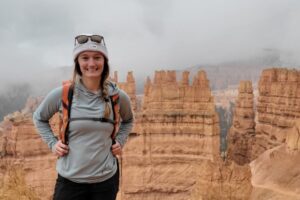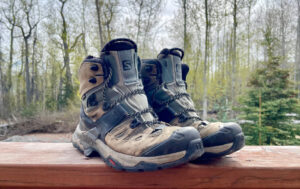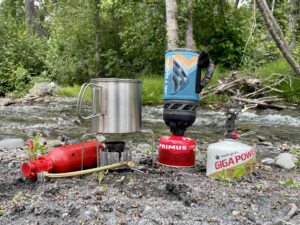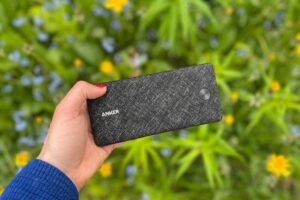Hiking pants are a critical piece of outdoor gear that protect our legs and help us regulate our temperature in both hot and cold weather. Finding the right pair of hiking pants isn’t always easy. Finding a pair of women’s pants can be even more difficult. With so many options to choose from, from high-waisted to low-waisted, stretchy to stiff, curvy to straight, picking out a pair that’s not only functional but fits you well is quite the task.
The ExplorersWeb team has tested over 10 pairs of women’s hiking pants to create this guide. We looked for pants that were breathable and gave protection from the sun and rain, didn’t restrict our movement, and fit a variety of women’s bodies.
If you’re looking for the right footwear to pair with your hiking pants, check out our guide to the Best Hiking Boots. If you’re looking for men’s hiking pants, head to our The Best Hiking Pants of 2024 guide.
Our Picks for the Best Women’s Hiking Pants
- Best Overall Women’s Hiking Pants: Kari Traa Henni Pants
- Best Lightweight Hiking Pants: Arcteryx Gamma Lightweight Pants
- Most Stylish Hiking Pants for Women: 5.11 Shella Pants
- Best Hiking Joggers: Kari Traa Thale Jogger Pants
- Best Hiking Leggings: Icebreaker Merino 260 Fastray High Rise Tights
Best Overall Women’s Hiking Pants:
Kari Traa Henni Pants
Features:
- 80% of the textiles in the pants are bluesign® approved
- PFAS-free water-repellent treatment
- 4-way stretch and articulated knees for increased mobility
- Ventilation zippers
- Large, zippered thigh pocket that easily fits phones
Why we like them: Comfortable softshell pants for hiking, climbing, or mountaineering
What we don’t like: Heavier fabric may not be suitable for hot conditions
Fabric: Polyamide 88%, elastane 12% | Fit: Regular | Weight: Unknown | Water Resistant: Yes | UPF: 40+ | Extended sizes/inseams?: No
The first thing we noticed on the Kari Traa Henni Pants ($150) was the large, zippered thigh pocket, perfect for holding your phone. Finding functional pockets on women’s pants is often a trial of patience and futility, but the Henni Pants did not disappoint. They also have zippered hand pockets, as well as zippered vents. The waistband is high and comfortable, and the pants come with four-way stretch, articulated knees, and a gusseted crotch for maximum mobility. They are one of the most comfortable pairs of pants we’ve ever worn and are perfect for hiking and climbing.
Kari Traa was founded by a woman and creates women-specific gear. They’ve also been PFAS-free since 2013, and their main fabric suppliers are bluesign® certified, meaning they only use safe input chemicals, monitor air and water emissions, and prioritize worker safety.
Best Lightweight Hiking Pants:
Arcteryx Gamma Lightweight Pants
Features: 
- Made from recycled materials
- Low profile belt doesn’t rub under a pack or harness
- Three zippered pockets
- UPF rating of 40+ for sun protection
- High elastane percentage for stretch
- Lightweight fabric that balances breathability with wind resistance
Why we like it: All of the best features of the Gamma Pants in incredibly lightweight, breathable material
What we don’t like: Thinner fabric may be less abrasion-resistant
Fabric: 86% nylon, 12% elastane | Fit: Fitted | Weight: 7.8 oz. | Water resistant: Yes | UPF: 40+ | Extended sizes/inseams?: 3 inseams available
The Arcteryx Gamma Lightweight Pants ($160) are made of a light, more breathable fabric and are our pick for lightweight pants. Chelsey has used the Gamma Lightweight Pants for years for her spring and fall backpacking and canyoneering trips in Utah. She likes the flexibility of the four-way stretch fabric and how lightweight the pants feel in hotter temperatures. They also have three zippered pockets for storing valuables. Despite their light weight, they also have adequate wind and water resistance, as well as UPF 40+ for sun protection.
She’s found that the pants are more prone to abrasion than the original Arcteryx Gamma Pants, though any pants would be hard-pressed to stand up to repeated seasons of slithering through Utah’s slot canyons.
Most Stylish Hiking Pants for Women:
5.11 Shella Pants

Features:
- Minimalist design for daily wear
- Reinforced belt loops
- Six total pockets, including large cargo pockets
- DWR finish
- Reinforced belt loops
- Extremely comfortable
Why we like them: Minimalist, casual enough for daily wear, very comfortable waistband
What we don’t like: No integrated belt or adjustable cuffs, only zipped back pockets
Fabric: 89% polyester, 11% elastane | Fit: Straight | Weight: 5.5 oz. | Water Resistant: Yes | UPF: No | Extended sizes/inseams?: 2 inseams available
The 5.11 Shella Pants ($68) are Chelsey’s favorite hiking pants for daily wear, long travel days, and day hikes. The stretchy, DWR-treated fabric is ideal for hiking, while the functionally minimalist look doesn’t look out of place for casual wear. Kirby and Chelsey thought they were one of the most comfortable pairs of hiking pants they tested. They have two hand pockets, two zippered back pockets, and two cargo pockets, providing ample storage.
Additionally, the belt loops are reinforced, so you can hang small items off them with a carabiner if needed. The waistband is also wider than many other women’s pants and doesn’t cut into our stomachs when sitting, squatting, or bending over.
Best Hiking Joggers:
Kari Traa Thale Jogger Pants
Features: 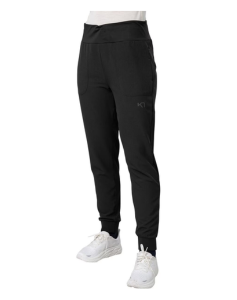
- High, wide waistband with drawstring for fit
- Made with recycled fabrics
- Secure, zipped hand pockets
- Ankle cuffs for a secure fit
Why we like them: Ridiculously comfortable, with athletic, breathable fabric
What we don’t like: Heavier than other jogger options
Fabric: 60% polyester, 30% recycled polyester, 10% elastane | Fit: Relaxed | Weight: N/A | Water resistant: | UPF: 40 | Extended sizes/inseams?: No
Durable, comfortable, and functional, the Kari Traa Thale Jogger Pants ($110) are our choice for the best hiking joggers on the market. Featuring a relaxed fit and straight leg, these joggers are classy enough to wear into town as well as on the trails. The wide, high waistband was designed with comfort in mind, with a drawstring to help secure the joggers at your waist. Two zipped hand pockets provide a secure place to keep things while out on the trail.
Best Hiking Leggings:
Icebreaker Merino 260 Fastray High Rise Tights

Features:
- 97% merino wool
- Stash pocket large enough for a phone
- High-rise waist
- Body contouring details
- Flatlock seams to prevent friction
Why we like them: Comfortable high waist, stash pocket for phones
What we don’t like: Not water or wind-resistant, expensive
Fabric: 97% merino wool, 3% elastane | Fit: Legging | Weight: 9 oz. | Water Resistant: No | UPF: No | Extended sizes/inseams?: No
Leggings are a popular choice for hiking because they are stretchy and can pull double duty at yoga, the gym, or layered under hiking pants during colder seasons. The IceBreaker Fastray High Rise Tights ($120) are Kirby’s favorite hiking tights. She likes the insulation the merino wool provides and how easy it is to move in them. The high waist also gives them a form-hugging and flattering fit, and there’s a gusseted crotch for increased mobility and airflow. While most leggings don’t have pockets, these feature a thigh stash pocket large enough for a phone. Like most leggings, these are not water or wind-resistant.
Honorable Mentions:
Prana Halle Pants

Features:
- Trouser-like pants for both active or casual wear
- Option to roll up pants and secure with a button closure
- Stretch Zion fabric
- Five total pockets
- DWR finish
- UPF 50+
Kirby and Chelsey tested the Prana Halle Pants while hiking, backpacking, and climbing. They liked the durability, the pockets, and the option to roll up the pants legs and secure them. However, Chelsey found that the pants stretched out a lot over a few days of wear, making for a baggy fit on backpacking trips. There’s also no integrated belt to help hold them up, and some of the pocket closures and the button at the waist eventually fell off.
About our testing process
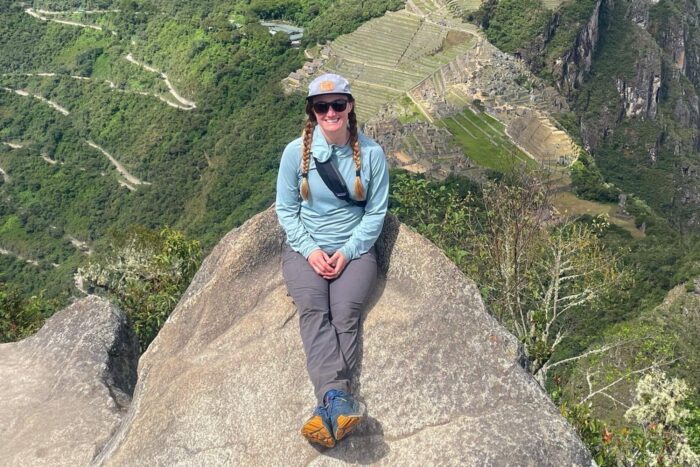
Chelsey believes that good pair of hiking pants should be versatile enough to long, difficult backpacking trips and sightseeing day trips to Machu Picchu. Photo: Chelsey Cook.
Gear Editor Chelsey Cook started the guide to women’s hiking pants in July 2024. She has over twenty years of experience hiking, backpacking, and mountaineering. She tested the pants in this guide on day hikes, backpacking trips, and longer expeditions in Alaska, Washington, Utah, Scotland, Peru, and the Faroe Islands.
Chelsey routinely spends several consecutive weeks wearing a single pair of hiking pants on expeditions and knows the value of a good pair of pants you don’t mind living in. Chelsey looks for hiking pants that are, above all else, comfortable and durable. She also likes pants that are designed to comfortably fit women’s bodies, look great in the frontcountry, and have large, functional pockets.
Kirby Kahl is a tester for our Best Hiking Pants guide, and several pairs that she tested also made it to our Best Women’s Hiking Pants guide. Kirby’s been hiking her entire life and is an avid rock climber. She likes hiking pants that can do it all. She tested the 5.11 Shella Pants, the IceBreaker Fastray High Rise Tights, and the Prana Halle Pants, wearing them on hiking trips and long alpine climbs.
We tested our hiking pants by wearing them as much as possible. Chelsey took a few of our favorite pairs canyoneering in Utah, and squeezing through slot canyons and stemming rough canyon walls quickly separated which pants could stand up to some abuse.
When testing the comfort and stretchiness of hiking pants, we wore them scrambling and rock climbing and looked for the pants that hindered us the least. We also tested hiking pants in a range of different conditions, from wet, cold, and snowy to hot and dry, and evaluated each pair for their breathability and wind- and water resistance.
Things to consider when buying women’s hiking pants
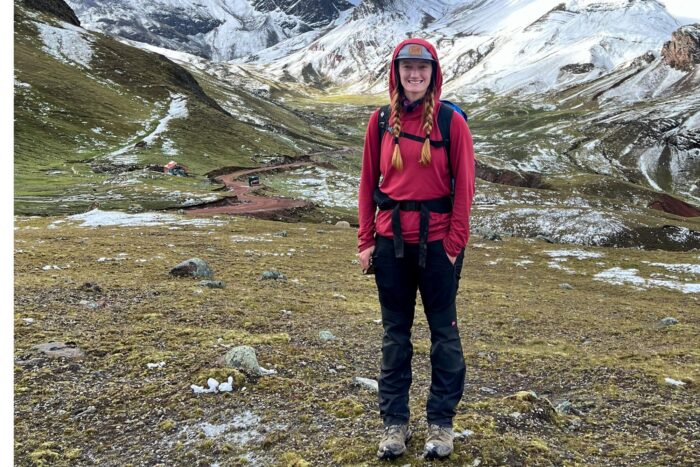
Thicker, more weather-proof hiking pants are a great option for high-altitude hikes, like in Peru’s Cusco region. Photo: Chelsey Cook
Types and lengths of hiking pants
Hiking pants come in different types, including traditional, convertible, roll-up, joggers, and tights. Traditional pants are typically full-length and water-resistant. These are a versatile option for most hiking needs, as the full-length legs will protect you from the sun and any bushwhacking and the DWR finish will keep you warm and dry during bad weather.
Convertible hiking pants — which aren’t featured in this guide — have zip-off legs that turn the pants into shorts. This is a great feature for all-day hikes or backpacking trips when it could be cool in the mornings and hot in the evenings. However, zip-off pants aren’t the most stylish, and you usually have to remove your hiking boots to pull the legs off. Roll-up pants are a happy medium between traditional and convertible pants. They have a button or drawcord that secures the pant cuff when you roll them up.
There are also hiking tights, like the IceBreaker Fastray High Rise Tights. Some people may find tights more comfortable than hiking pants. However, they don’t offer any weather protection and snag easily on rocks and branches. There are also joggers, which are essentially loose tights. Some joggers provide weather protection.
Materials
Most of the hiking pants in this guide and on the market are made of a blend of different synthetic materials, like polyester or nylon, and an elastic fiber like elastane. Polyester and nylon are durable fibers, while elastane gives hiking pants some stretch. Coupled with a water-repellent finish, this fabric is often called “soft-shell,” and is both breathable and protective.
Cotton blends are also occasionally used in hiking pants. This material is very breathable but absorbs moisture and isn’t insulating when wet. Cotton pants should be reserved for hot, dry climates and are not featured in this guide.
Hiking tights and joggers are generally made of the same materials as hiking pants, though some feature merino wool, which wicks away moisture, prevents odor buildup, and will keep you warm even when wet.
Weather protection
Hiking pants, particularly soft-shell ones, often have a durable water-repellent finish (DWR). A DWR coating doesn’t necessarily mean waterproof, but it does add enough water resistance to keep you dry when hiking in light rain or through wet foliage. It does lower breathability, however, and water-resistant pants often feel heavier.
Some hiking pants, like the Prana&subId2=explorersweb Halle Pants, also have a UPF (ultraviolet protection factor) rating, which measures how well the fabric blocks harmful UV radiation from the sun. The higher the UPF rating, the more UV radiation the fabric blocks. If you hike in the desert or at high altitudes, consider hiking pants with a high UPF for added protection.
Mobility and fit
Hiking pants should move with you. You may not need the stretchiest pants on the market if you usually hike well-groomed trails, but if you plan on scrambling or climbing in your pants, you’ll want those with a higher percentage of stretchy materials like elastane. Features like a gusseted crotch and articulated knees also improve the range of motion.
Hiking pants come in a variety of fits. Slim fits may restrict motion, while baggier fits could snag on rocks and undergrowth. It can be particularly difficult to find pants that fit if you have a female-shaped body. Some brands offer extended sizing for their hiking pants, while other brands offer different inseam lengths and curved versions.
Because everyone is shaped differently, it’s best to try on several different pairs of hiking pants before settling on one you like. You want your pants to fit snuggly, but not restrict your movement. If you will carry a heavy backpack, look for hiking pants that don’t require you to wear a belt, as a belt can rub against a pack and your skin.
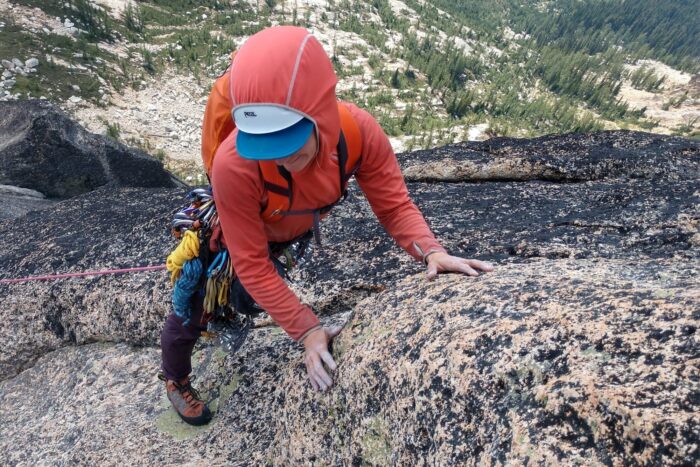
We tested mobility by taking our hiking pants rock climbing. Photo: Chelsey Cook
Additional features
Hiking pants’ designs range from fully featured to minimalist. Ideally, you want a pair of pants that have all the features you find necessary without adding weight or restricting movement.
If you like carrying things in your pockets, look for pants with a mix of large cargo pockets and zipped pockets for extra protection. Historically, one of the main complaints we’ve had for women’s hiking pants is not having large, functional pockets. Thankfully, the market seems to be catching on. We particularly loved the secure thigh pockets on the Kari Traa Henni Pants.
Waist closures are also an important feature. Most hiking pants have a zipper and button closure, while joggers and tights have a stretchy, thick waistband. Integrated belts can also be a nice feature, but make sure the system is comfortable and, if you’re going backpacking, minimal enough that it won’t rub against a backpack’s hip belt.
Some pants come with adjustable cuffs, which can be helpful if you wear a variety of different shoes and boots when hiking.
Frequently asked questions about women’s hiking pants
What types of pants are best for hiking?
The type of hiking pants that works best for you depends on where you hike, what weather you hike in, the duration of your hiking trips, and your personal preferences. If you hike in cold, wet conditions, look for pants with a DWR finish. If you prefer to hike in the desert or hot conditions, look for lighter fabrics with a UPF rating, convertible pants, or roll-up pants. Above all, make sure your hiking pants fit you well and don’t restrict your movement.
Should hiking pants be loose or tight?
Hiking pants should be comfortable and not impede your movement. They should neither be too tight nor too loose. Here’s how you can test your pants before you venture onto the trail with them.
Squat – Your pants shouldn’t pinch you anywhere when squatting, or riding up more than a few inches. The waist should still be flush against your back.
Sit – If the pants are tight or uncomfortable when sitting, you may need another size or another design.
Raise one knee at a time – Raise each knee as high as possible. Your pants shouldn’t block your movement, pinch at your hips, split at the crotch, or ride up more than a few inches.
Do I need to wear long pants when hiking?
This comes down to personal preference and where you are hiking. Full-length pants provide optimal protection from rain, sun, mosquitoes, and abrasions from rocks and undergrowth. However, even the lightest pair of hiking pants can feel too hot on warm days. If you mostly hike in the desert, you may appreciate the breathability of shorts. Just make sure to wear plenty of sunscreen on your lower legs if you do.
Can I hike in jeans?
Jeans are a great choice for the frontcountry, but not for hiking. They’re made of cotton, which doesn’t wick away moisture or insulate when wet. They’re also not breathable, don’t stretch, and are heavy compared to hiking pants.
What shoes should I wear with hiking pants?
You should wear sturdy shoes that offer good foot support and protection. Check out our Best Hiking Boots of 2024 for a full guide.

